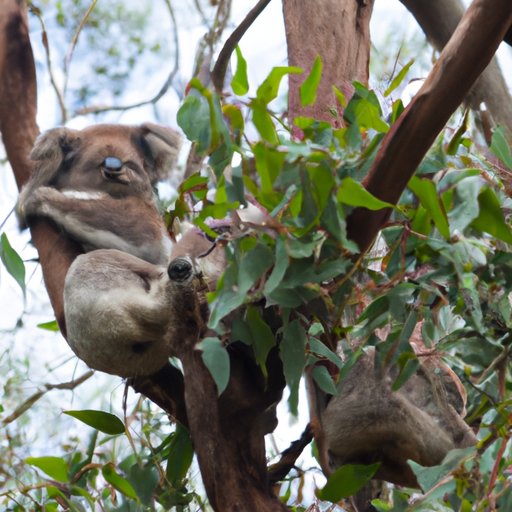Introduction
Koalas are a beloved species that have become an iconic symbol of Australia. They are often referred to as “teddy bears” due to their cuddly appearance, but they are actually marsupials that live in eucalyptus trees. Unfortunately, their population is declining due to a variety of factors, including loss of habitat, human activity, and disease.

A Comprehensive Look at the Decline of Koalas: Causes and Solutions
Loss of habitat is one of the primary causes of the decline in koala populations. With increasing urbanization and agricultural development, natural areas are being lost or degraded, leaving few suitable habitats for koalas. This is compounded by the fact that koalas are very particular about the type of tree they feed from, and the eucalyptus trees they rely on are being cleared away.
Human activity also plays a role in the decline of koala populations. Koalas are killed by cars when crossing roads, and their habitat is often destroyed by logging or mining activities. Furthermore, people often hunt koalas for their fur or meat, further reducing their numbers.
In addition to habitat destruction and hunting, koalas are also threatened by disease and predation. Chlamydia is a common disease among koalas, and can cause infertility, blindness, and death. Koalas are also preyed upon by foxes, cats, and dogs, which can further reduce their numbers.
Fortunately, there are a number of possible solutions to the decline of koala populations. Conservation efforts such as creating protected areas for koalas, breeding programs to increase their numbers, and reforestation projects to restore their habitat can all help to protect and preserve koalas.
An In-Depth Analysis of the Koala Population: What Can We Do to Save Them?
Conservation efforts are key to protecting koala populations. Governments and organizations around the world are working to create protected areas for koalas, where they are safe from human activities that could damage their habitat. These areas provide refuge for koalas, and can also be used for research and public education.
In addition to creating protected areas, breeding programs are also being implemented to increase koala numbers. These programs involve carefully selecting and breeding pairs of koalas with desirable traits, such as disease resistance or reproductive success. By ensuring that koalas are bred with the best possible genetic makeup, these programs can help to boost koala populations.
Reforestation projects are also being undertaken to restore koala habitat. These projects involve planting trees, such as eucalyptus trees, in areas that have been cleared for development or agriculture. Reforestation projects not only provide food sources for koalas, but also help to prevent soil erosion and improve water quality.
How Many Koalas are Left in the World?
Estimating the current koala population is difficult, as they are spread across wide geographic areas and are difficult to track. However, it is estimated that there are between 43,000 and 80,000 koalas left in the wild. The largest populations are found in New South Wales and Queensland, with smaller populations in Victoria, South Australia, and Western Australia.
The Alarming Numbers Behind the Loss of Koalas
It is estimated that koala populations have declined by as much as 80% since European settlement in Australia. This is largely due to habitat destruction and hunting, as well as diseases like chlamydia, which have caused fertility issues and infant mortality in koalas. In some areas, koala populations have been reduced to just a few hundred individuals.
Recent losses have been severe, with estimates suggesting that up to 1,000 koalas have been killed each year since 2007. Without intervention, koala populations are expected to decline further over the next two decades, and may even become extinct in some areas.

Exploring the Impact of Human Activity on Koala Populations
Human activity has had a significant impact on koala populations, both directly and indirectly. Direct effects include hunting, habitat destruction, and the introduction of predators like foxes and cats. Indirect effects include climate change, which affects the availability of food and water sources, and pollution, which can interfere with koalas’ sense of smell and make it more difficult for them to find food.
Conclusion
Koala populations are in decline, and without intervention, they could become extinct in some areas. Loss of habitat, human activity, and disease are the main causes of their decline, but there are a number of possible solutions, including conservation efforts, breeding programs, and reforestation projects. While there is still much work to be done, these efforts can help to protect and preserve koala populations for future generations.
The exact number of koalas left in the world is difficult to determine, but estimates suggest that there are between 43,000 and 80,000 remaining. Recent losses have been severe, and without intervention, koala populations are expected to decline further in the coming years. Human activity has had a significant impact on koala populations, both directly and indirectly, and this must be addressed if we are to save the species.


